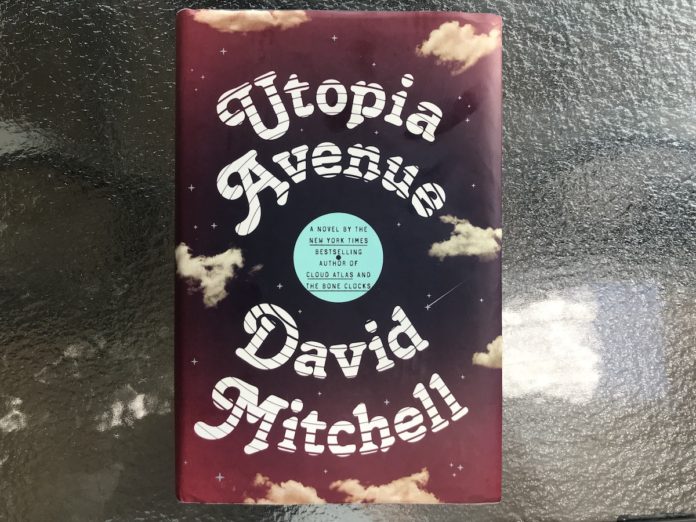Utopia Avenue, David Mitchell’s latest book, was released on July 14. While an enjoyable, and well-written read, it is a rather inconsequential book compared to the majority of Mitchell’s writing.
Mitchell is a British author well-known for best-selling books such as The Bone Clocks (2014) and Cloud Atlas (2004), which was later adapted into a 2012 movie of the same name. He’s known for fusing realism with fantasy and for often having main characters from one book appear in others as minor characters.
Utopia Avenue is the name of the book’s eponymous band, and the story follows them through their rise to stardom in 1967 London. Mitchell tells most of the story from three major perspectives: brusque bassist Dean Moss, eccentric Dutch-English guitarist Jasper de Zoet, and pianist Elf Holloway, who is coming to terms with her sexuality. The drummer Peter “Griff” Griffin and the band’s Canadian manager Levon Frankland also offer narrative perspective once each in the novel. Mitchell artfully differentiates characters through thought patterns and vocabularies, so no two characters are too similar when reading from their perspectives.
Utopia Avenue was a bit self-indulgent. Occasionally, the dialogue seemed artificial and implausibly articulate and elegant, draining life from the characters and reducing them to ink on the page. While I’m sure that some readers would have fun with the appearances of Leonard Cohen, Jimi Hendrix, and David Bowie in the novel, the way Mitchell constructed them seemed too good to be true: too funny, too charming, too flawless.
Mitchell’s protagonists were also all white, and there were few speaking parts given to people of colour in the book. If Mitchell could conjure up immortal human beings, could he not make some main characters who were Black, brown or Indigenous?
This ignorance was accentuated by the racial slurs used by white characters in the book, which I found cheap and wholly unnecessary. While occasional, the slurs were used enough that reading these passages became unpleasant. In reference to certain appearances and clothing, these slurs were completely avoidable. Mitchell does have a habit of using these slurs in his book—sparsely, yet frequently enough to be remembered. Regardless of whether the novel is set in the past or not, no white writer should take the liberty to use these slurs that Mitchell included.
Despite this glaring flaw, Mitchell is fantastic with his imagery. He uses active, short sentences, and creative verbs, which help to create a clear picture in the reader’s mind. For example, in describing a scene in Italy, he writes, “Starlings streamed through gaps of sky. A tall, narrow gateway drew Dean up a half-dozen steps and into a church. Gold glittered on darkness. Incense hung in the air. People came in, lit candles, knelt, prayed and left like customers in a post office.”
The book was its strongest and most readable during de Zoet’s storyline, in which Mitchell brought his familiar fantastical edge out to play. Mitchell painstakingly embroidered the young man’s story arch with such care and detail that when de Zoet’s story reaches its summit, you realize that Mitchell embedded details of his ending at the beginning of the book. It’s a psychological déjà-vu trick played on the reader, and I couldn’t help but love it.
Mitchell is known for his “meta-novel” style of writing, in which each seemingly unrelated novel is a chapter in an ornate, larger novel. Mitchell told Radio New Zealand in an interview earlier this month that he sees this novel as a “standalone self-contained novel,” as well as “one more chapter in this strange, lifelong, meta-novel I’m putting together.” I’m not sure I agree with Mitchell. While the novel may seem to have legs on its own, there’s one too many nods to his past works that I’d feel slightly confused if I had only read Utopia Avenue, as if I were entering a conversation made of inside jokes.
While a beautifully-crafted novel, Utopia Avenue was disappointing, and at parts uncomfortable to read. Mitchell shouldn’t have focused on an all-white cast of characters, and should not have included the slurs in the novel. I would much sooner recommend one of Mitchell’s earlier works before jumping off into this decidedly later, and unsatisfying, chapter of his “meta-novel.”
Utopia Avenue, as well as Mitchell’s other books, can be found at your local bookstore. Click here to find the closest shop.
Featured image by Talar Stockton.






